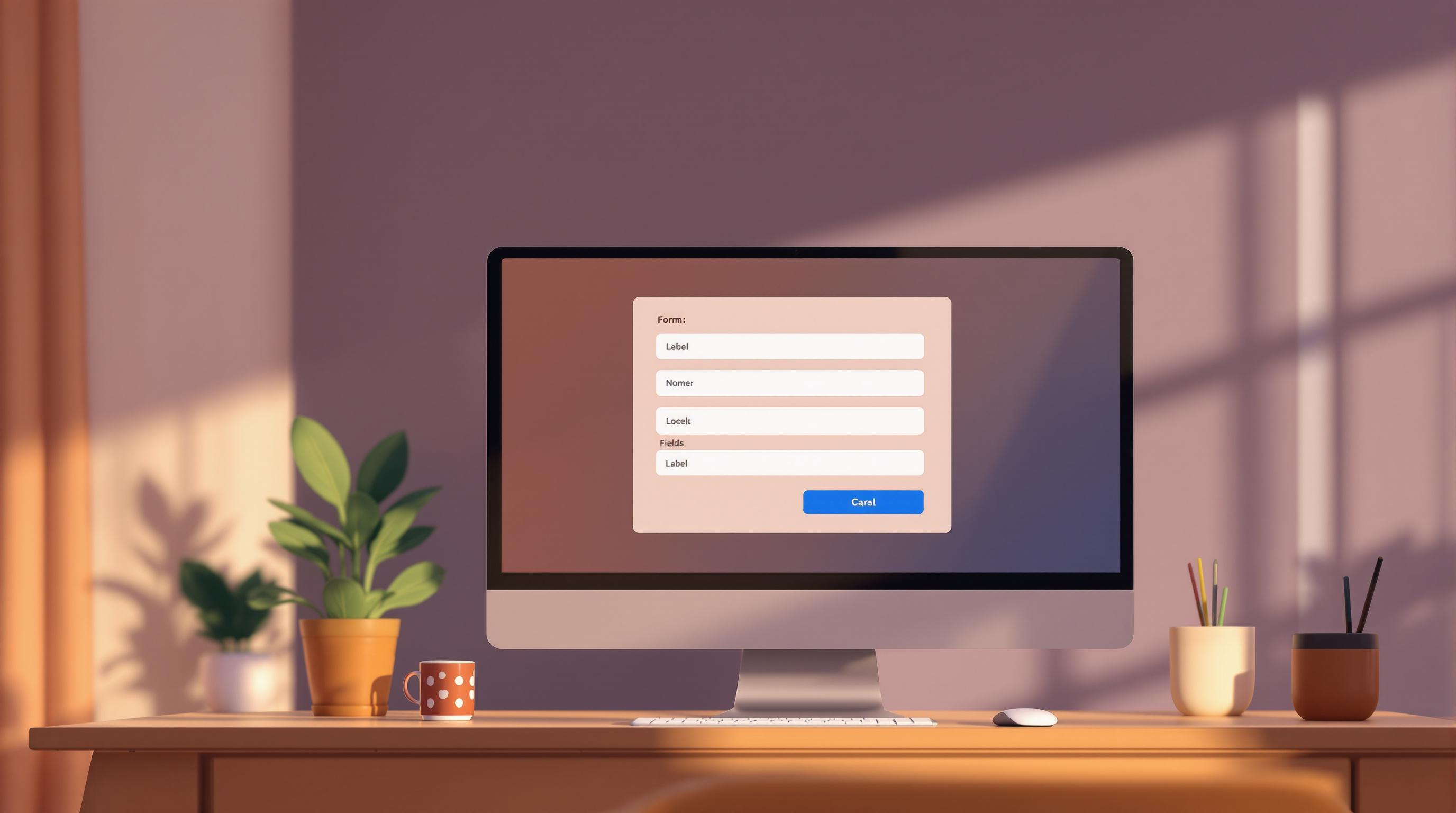Ultimate Guide to Field Label Accessibility

Field label accessibility ensures online forms are easy to use for everyone, including users with disabilities. Here’s what you need to know:
- What Are Field Labels? Text that explains what each form field is for. Unlike placeholder text, labels stay visible while typing.
- Why It Matters: Clear labels improve form completion rates, enhance user experience, and comply with accessibility standards (like WCAG).
- Common Issues: Missing labels, hidden labels, vague text, or relying only on placeholders can confuse users or make forms unusable with assistive technologies.
- Best Practices:
- Use visible, clear, and specific labels.
- Link labels to fields using proper HTML (
<label for="id">) or ARIA attributes for complex cases. - Test with screen readers and ensure proper contrast and readability.
Accessible labels make forms easier to navigate for everyone while meeting legal requirements.
For detailed tips, solutions, and examples, read on.
How to make accessible forms - with lots of examples!
Label Design Standards
Designing field labels requires both visual and technical accuracy to ensure they are accessible and effective. Below, we break down the key standards and practices to follow.
Label Visibility Rules
Labels should always be easy to see and read, no matter the interaction. Here’s how to ensure their visibility:
- Ensure there’s enough contrast between the label text and its background.
- Use a legible font size and keep label positioning consistent.
- Make sure labels remain visible throughout the entire form process.
HTML Label Connections
For labels to function properly, they must be correctly linked to their corresponding form fields. Here are the main methods:
| Connection Method | Implementation | Purpose |
|---|---|---|
| Explicit Labels | <label for="input-id"> |
Links the label directly to the input field. |
| Implicit Labels | <label><input></label> |
Wraps the input field within its label. |
| ARIA Labels | aria-labelledby="label-id" |
Provides alternative labeling for complex components. |
Writing Clear Labels
Labels should be straightforward and easy to understand. Follow these tips:
- Use Direct, Actionable Language: Write labels that clearly state what information is needed and avoid confusing terms or jargon.
- Keep Formatting Consistent: Use the same style throughout, including capitalization, punctuation, and terminology.
- Provide Specific Details: Include any necessary instructions in the label itself, like "Password (8+ characters)" to guide users.
| Label Component | Good Example | Poor Example |
|---|---|---|
| Field Purpose | Email Address | Contact |
| Required Fields | Full Name * | Name (mandatory) |
| Input Format | Phone (XXX-XXX-XXXX) | Phone Number |
Clear, well-designed labels not only improve user experience but also boost form completion rates. By following these best practices, you can create forms that are accessible and easy to use.
ARIA Label Implementation

ARIA (Accessible Rich Internet Applications) attributes provide additional tools to improve the accessibility of form fields, especially for users who depend on assistive technologies. While HTML labels are essential, ARIA attributes refine accessibility for more complex controls. These attributes work alongside standard HTML labels to improve how forms are navigated and understood.
ARIA Label Types
ARIA labels come in various forms, each designed for specific accessibility scenarios:
| ARIA Attribute | Purpose | Best Use Case |
|---|---|---|
aria-label |
Adds a direct text label | Hidden elements, icon buttons |
aria-labelledby |
Links to visible text elements | Complex form controls |
aria-describedby |
Provides additional descriptions | Error messages, help text |
ARIA Usage Guidelines
Once you've chosen the right ARIA attribute, follow these steps to ensure proper implementation:
1. Start with Native HTML
Always begin with HTML labels as your foundation. Use ARIA attributes to enhance accessibility where needed.
<label for="email">Email Address</label>
<input
type="email"
id="email"
aria-describedby="email-help"
/>
<span id="email-help">Enter a valid email address (e.g., user@example.com)</span>
Once your HTML structure is in place, apply ARIA attributes for more complex controls or additional context.
2. Select the Right Attribute
Choose ARIA attributes based on your specific requirements:
| Scenario | Recommended Attribute | Example Usage |
|---|---|---|
| Icon-only buttons | aria-label |
<button aria-label="Close dialog">×</button> |
| Complex form groups | aria-labelledby |
<fieldset aria-labelledby="address-group"> |
| Additional instructions | aria-describedby |
<input aria-describedby="password-requirements"> |
3. Thoroughly Test Your Implementation
- Use screen readers like NVDA or VoiceOver to confirm that labels are announced correctly.
- Ensure ARIA attributes do not conflict with existing HTML labels.
- Test across different browsers and assistive technologies to ensure compatibility.
ARIA labels should deliver clear and concise information that helps users understand each field's purpose. Avoid overusing ARIA attributes, as unnecessary additions can confuse users relying on screen readers.
For more intricate form controls, combine ARIA attributes thoughtfully:
<div role="group" aria-labelledby="shipping-title">
<h3 id="shipping-title">Shipping Address</h3>
<input
type="text"
aria-label="Street address"
aria-describedby="address-format"
/>
<span id="address-format">Include apartment or suite number if applicable</span>
</div>
sbb-itb-5f36581
Label Mistakes to Avoid
Creating accessible labels goes beyond meeting design standards - it also means steering clear of common mistakes.
Placeholder Text Problems
Placeholder text often causes usability issues. Here are some common problems and how to solve them:
| Problem | Impact | Fix |
|---|---|---|
| Text Disappears | Placeholder text vanishes when users type | Use permanent labels instead |
| Poor Contrast | Text fails to meet WCAG 2.1 contrast ratio of 4.5:1 | Ensure proper contrast |
| Memory Burden | Users must remember instructions once text disappears | Keep instructions visible at all times |
Here’s a better way to structure your form:
<label for="phone">Phone Number</label>
<input
type="tel"
id="phone"
placeholder="(555) 555-5555"
aria-describedby="phone-format"
/>
<span id="phone-format">Format: (XXX) XXX-XXXX</span>
Good labels should always be clear and permanent, ensuring users can understand them without extra effort.
Vague Label Text
Unclear labels can confuse users. Here’s how to improve them:
- Replace technical jargon (e.g., change "SKU" to "Product Code").
- Avoid overly generic labels like "Info" or "Other."
- Stick to consistent terminology across your forms.
For example:
<label for="birth-date">Date of Birth</label>
<span id="date-format">MM/DD/YYYY</span>
Keep instructions simple and concise to make them easier to follow.
Simplifying Labels
Overly complex labels can overwhelm users. Here's how to simplify them:
| Original Label | Simplified Version | Why It’s Better |
|---|---|---|
| "Please Enter Your Primary Contact Phone Number" | "Phone Number" | Short and to the point |
| "Billing Address (Where You Receive Bills)" | "Billing Address" | Removes unnecessary details |
| "Select Your Preferred Method of Communication" | "Contact Preference" | More direct |
For more detailed instructions, use supporting elements like this:
<label for="password">Password</label>
<input
type="password"
id="password"
aria-describedby="password-requirements"
/>
<div id="password-requirements">
Must include 8+ characters, numbers, and special characters
</div>
Label Testing Methods
After creating accessible labels, it's crucial to test their functionality to ensure they work as intended.
Screen Reader Checks
Make sure screen readers announce labels properly. Here's an example of a correctly connected label and input:
<!-- Example of properly connected label and input -->
<label for="email">Email Address</label>
<input
type="email"
id="email"
aria-describedby="email-hint"
/>
<span id="email-hint">We'll never share your email</span>
| Check | Issue | Fix |
|---|---|---|
| Label Text | Missing for attribute |
Add matching for and id |
| Description | Incorrect aria-describedby |
Link correct description ID |
| Field Context | Missing input types | Specify correct input type |
| Error Messages | Errors not linked | Connect errors to fields |
Browser Autofill Tests
Properly implemented labels also ensure smooth browser autofill functionality. Here's what to check:
| Label Type | Autofill | Check |
|---|---|---|
| Name Fields | First/Last Name | Use standard name format |
| Address Fields | Street/City/State | Verify address autofill |
| Contact Info | Email/Phone | Confirm common formats |
| Payment Info | Card/Expiry | Ensure secure field detection |
Regular Label Reviews
Regular reviews help maintain label accessibility and usability. Focus on these areas:
-
Monthly Audits and Documentation
- Perform accessibility checks.
- Document any changes or issues.
- Track improvements over time.
- Keep testing procedures up to date.
-
User Feedback Integration
- Gather feedback from users regarding accessibility.
- Resolve reported issues promptly.
- Look for recurring feedback patterns to improve design.
Here's an example of a well-documented label:
<!-- Example of well-documented label -->
<label for="phone">Phone Number</label>
<input
type="tel"
id="phone"
pattern="[0-9]{3}-[0-9]{3}-[0-9]{4}"
aria-describedby="phone-format"
/>
<span id="phone-format">Format: XXX-XXX-XXXX</span>
"Ensure your forms are easy to navigate for all users, complying with accessibility standards to reach a wider audience." - Reform
Next, we'll dive into key takeaways for keeping forms accessible.
Next Steps
After testing your labels, follow these steps to ensure your forms remain accessible to all users.
Main Points Review
Here's a quick summary of the key requirements discussed in this guide:
| Aspect | Key Requirements | Usage Tips |
|---|---|---|
| Label Design | High visibility and contrast | Place labels above or to the left of fields |
| HTML Structure | Proper label-field connections | Use matching "for" and "id" attributes |
| ARIA Support | Use correct ARIA attributes | Add descriptive "aria-label" when needed |
| Testing Protocol | Perform regular checks | Include screen reader testing |
Consistent testing ensures your forms stay user-friendly and accessible.
Reform's Accessibility Tools

Reform offers built-in tools to simplify accessibility compliance by automating best practices. These tools use real-time analytics to flag potential accessibility issues based on actual user behavior.
Some standout features include:
| Feature | Benefit | Impact |
|---|---|---|
| Auto-generated ARIA Labels | Improves screen reader compatibility | Makes form navigation easier |
| Contrast Validation | Ensures text is readable | Improves visibility for users |
| Real-time Testing | Detects potential problems | Allows for quick fixes |
| Custom CSS Support | Enables specific adjustments | Meets unique user requirements |
Related posts
Get new content delivered straight to your inbox

The Response
Updates on the Reform platform, insights on optimizing conversion rates, and tips to craft forms that convert.
Drive real results with form optimizations
Tested across hundreds of experiments, our strategies deliver a 215% lift in qualified leads for B2B and SaaS companies.





